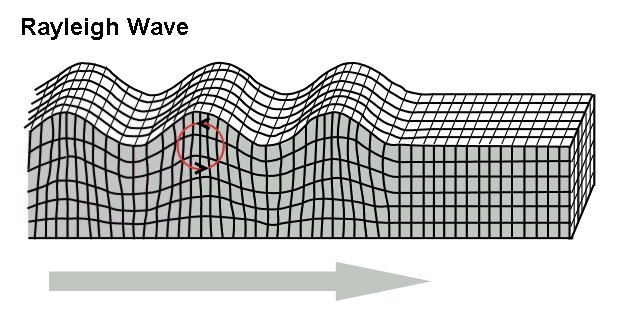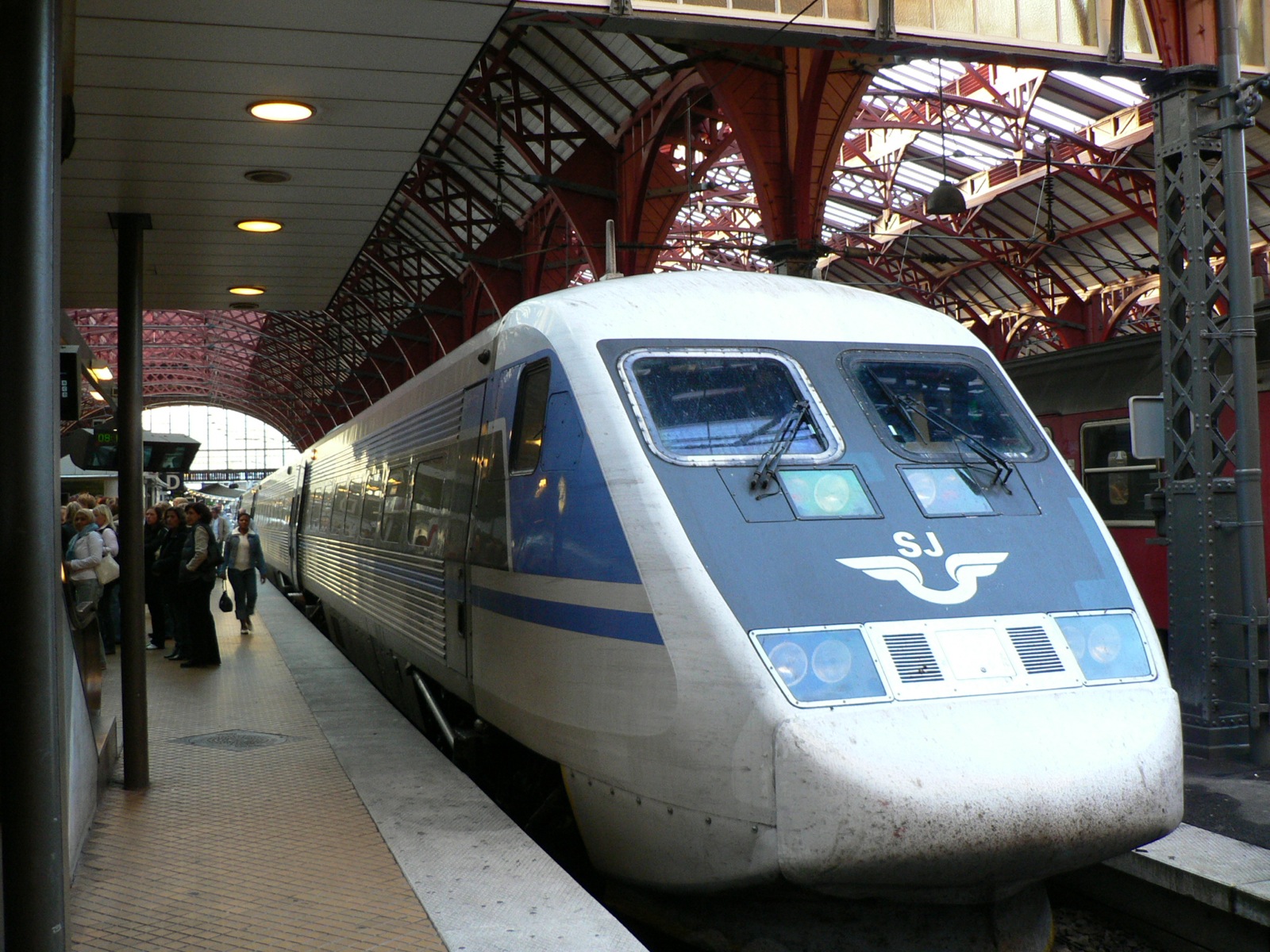|
Ground Vibration Boom
Ground vibration boom is a phenomenon of very large increase in ground vibrations generated by high-speed railway trains travelling at speeds higher than the velocity of Rayleigh surface waves in the supporting ground. Technical background This phenomenon, which is similar to a sonic boom from supersonic aircraft, was theoretically predicted in 1994. Its first experimental observation took place in 1997-1998 on the newly built high-speed railway line in Sweden (from Gothenburg to Malmo) for high-speed trains X 2000. At some locations along this line characterised by very soft ground (near Ledsgard) the Rayleigh wave velocity was as low as , and train speeds of only were sufficient to observe the effect. In particular, the increase in train speeds from was accompanied by about tenfold increase in generated ground vibration level, which agrees with the theory. It is now understood that, with the increase of operating train speeds, this phenomenon represents a major environment ... [...More Info...] [...Related Items...] OR: [Wikipedia] [Google] [Baidu] |
Ground Vibrations
Ground vibrations is a technical term that is being used to describe mostly man-made vibrations of the ground, in contrast to natural vibrations of the Earth studied by seismology. For example, vibrations caused by explosions, construction works, railway and road transport, etc. - all belong to ground vibrations. General information Ground vibrations are associated with different types of elastic waves propagating through the ground. These are surface waves, mostly Rayleigh waves, and bulk longitudinal waves and transverse waves (or shear waves) propagating into the ground depth. Typical frequency range for environmental ground vibrations is 1 – 200 Hz. Waves of lower frequencies (below 1 Hz) are usually called microseisms, and they are normally associated with natural phenomenae, e.g. water waves in the oceans. Environmental ground vibrations generated by rail and road traffic may cause annoyance to residents of nearby buildings both directly and via generated struct ... [...More Info...] [...Related Items...] OR: [Wikipedia] [Google] [Baidu] |
Rayleigh Wave
Rayleigh waves are a type of surface acoustic wave that travel along the surface of solids. They can be produced in materials in many ways, such as by a localized impact or by Piezoelectricity, piezo-electric Interdigital transducer, transduction, and are frequently used in non-destructive testing for detecting defects. Rayleigh waves are part of the seismic waves that are produced on the Earth by earthquakes. When guided in layers they are referred to as Lamb waves, Rayleigh–Lamb waves, or generalized Rayleigh waves. Characteristics Rayleigh waves are a type of surface wave that travel near the surface of solids. Rayleigh waves include both longitudinal and transverse motions that decrease exponentially in amplitude as distance from the surface increases. There is a phase difference between these component motions. The existence of Rayleigh waves was predicted in 1885 by Lord Rayleigh, after whom they were named. In isotropic solids these waves cause the surface particles ... [...More Info...] [...Related Items...] OR: [Wikipedia] [Google] [Baidu] |
Swedish High-speed Train X2000 At Ledsgard
Swedish or ' may refer to: Anything from or related to Sweden, a country in Northern Europe. Or, specifically: * Swedish language, a North Germanic language spoken primarily in Sweden and Finland ** Swedish alphabet, the official alphabet used by the Swedish language * Swedish people or Swedes, persons with a Swedish ancestral or ethnic identity ** A national or citizen of Sweden, see demographics of Sweden ** Culture of Sweden * Swedish cuisine See also * * Swedish Church (other) * Swedish Institute (other) * Swedish invasion (other) * Swedish Open (other) Swedish Open is a tennis tournament. Swedish Open may also refer to: * Swedish Open (badminton) * Swedish Open (table tennis) * Swedish Open (squash) * Swedish Open (darts) {{disambiguation ... {{disambig Language and nationality disambiguation pages ... [...More Info...] [...Related Items...] OR: [Wikipedia] [Google] [Baidu] |
Sonic Boom
A sonic boom is a sound associated with shock waves created when an object travels through the air faster than the speed of sound. Sonic booms generate enormous amounts of sound energy, sounding similar to an explosion or a thunderclap to the human ear. The crack of a supersonic bullet passing overhead or the crack of a bullwhip are examples of a small sonic boom. Sonic booms due to large supersonic aircraft can be particularly loud and startling, tend to awaken people, and may cause minor damage to some structures. This led to the prohibition of routine supersonic flight overland. Although sonic booms cannot be completely prevented, research suggests that with careful shaping of the vehicle, the nuisance due to sonic booms may be reduced to the point that overland supersonic flight may become a feasible option. A sonic boom does not occur only at the moment an object crosses the sound barrier and neither is it heard in all directions emanating from the supersonic objec ... [...More Info...] [...Related Items...] OR: [Wikipedia] [Google] [Baidu] |
Supersonic Aircraft
A supersonic aircraft is an aircraft capable of supersonic flight, that is, flying faster than the speed of sound (Mach number, Mach 1). Supersonic speed, Supersonic aircraft were developed in the second half of the twentieth century. Supersonic aircraft have been used for research and military purposes, but only two supersonic aircraft, the Tupolev Tu-144 (first flown on December 31, 1968) and the Concorde (first flown on March 2, 1969), ever entered service Supersonic transport, for civil use as airliners. Fighter aircraft, Fighter jets are the most common example of supersonic aircraft. The aerodynamics of supersonic flight is called compressible flow because of the compression (physics), compression associated with the shock waves or "sonic boom" created by any object traveling faster than sound. Aircraft flying at speeds above Mach 5 are called Hypersonic flight, hypersonic aircraft. Supersonic speed is reckoned with respect to air speed; higher speeds can be achieved in te ... [...More Info...] [...Related Items...] OR: [Wikipedia] [Google] [Baidu] |
X 2000
X 2000, officially designated X2, is an electric high-speed tilting train operated by SJ in Sweden. It has a top commercial speed of 200 km/h (124 mph) and a top design speed of 210 km/h (130 mph) but has achieved a maximum speed of 276 km/h (171 mph) in tests. It primarily serves major routes, including Stockholm–Gothenburg and Stockholm–Malmö–Copenhagen. The X2 project began in 1969 as a collaboration between Kalmar Verkstad, Swedish State Railways (SJ), and ASEA. In 1986, SJ placed an order for 20 sets of a new type of train. Asea was responsible for manufacturing the electrical components, while Kalmar Verkstad (Statsföretag) was responsible for the mechanical design and manufacturing. Ultimately, a total of 44 train sets were built. The trains, designed and manufactured in Kalmar, Sweden, were launched in 1990 as a first-class only train with a meal included in the ticket price, and free use of the train's fax machine. From 1995 second class was introdu ... [...More Info...] [...Related Items...] OR: [Wikipedia] [Google] [Baidu] |
High-speed Trains
High-speed rail (HSR) is a type of rail transport network utilising trains that run significantly faster than those of traditional rail, using an integrated system of specialised rolling stock and dedicated tracks. While there is no single definition or standard that applies worldwide, lines built to handle speeds of at least or upgraded lines of at least are generally considered to be high-speed. The first high-speed rail system, the Tōkaidō Shinkansen, began operations in Honshu, Japan, in 1964. Due to the streamlined spitzer-shaped nose cone of the trains, the system also became known by its English nickname bullet train. Japan's example was followed by several European countries, initially in Italy with the Direttissima line, followed shortly thereafter by France, Germany, and Spain. Today, much of Europe has an extensive network with numerous international connections. Construction since the 21st century has led to China taking a leading role in high-speed rail. , ... [...More Info...] [...Related Items...] OR: [Wikipedia] [Google] [Baidu] |
Rayleigh Waves
Rayleigh waves are a type of surface acoustic wave that travel along the surface of solids. They can be produced in materials in many ways, such as by a localized impact or by piezo-electric transduction, and are frequently used in non-destructive testing for detecting defects. Rayleigh waves are part of the seismic waves that are produced on the Earth by earthquakes. When guided in layers they are referred to as Lamb waves, Rayleigh–Lamb waves, or generalized Rayleigh waves. Characteristics Rayleigh waves are a type of surface wave that travel near the surface of solids. Rayleigh waves include both longitudinal and transverse motions that decrease exponentially in amplitude as distance from the surface increases. There is a phase difference between these component motions. The existence of Rayleigh waves was predicted in 1885 by Lord Rayleigh, after whom they were named. In isotropic solids these waves cause the surface particles to move in ellipses in planes nor ... [...More Info...] [...Related Items...] OR: [Wikipedia] [Google] [Baidu] |
Mach Number
The Mach number (M or Ma), often only Mach, (; ) is a dimensionless quantity in fluid dynamics representing the ratio of flow velocity past a boundary to the local speed of sound. It is named after the Austrian physicist and philosopher Ernst Mach. \mathrm = \frac, where: * is the local Mach number, * is the local flow velocity with respect to the boundaries (either internal, such as an object immersed in the flow, or external, like a channel), and * is the speed of sound in the medium, which in air varies with the square root of the thermodynamic temperature. By definition, at Mach1, the local flow velocity is equal to the speed of sound. At Mach0.65, is 65% of the speed of sound (subsonic), and, at Mach1.35, is 35% faster than the speed of sound (supersonic). The local speed of sound, and hence the Mach number, depends on the temperature of the surrounding gas. The Mach number is primarily used to determine the approximation with which a flow can be treated as an i ... [...More Info...] [...Related Items...] OR: [Wikipedia] [Google] [Baidu] |
Supershear Earthquake
In seismology, a supershear earthquake is when the propagation of the Earthquake rupture, rupture along the Fault (geology), fault surface occurs at speeds in excess of the seismic S wave, shear wave (S wave) velocity. This causes an effect analogous to a sonic boom. Rupture propagation velocity During seismic events along a fault surface the displacement initiates at the focus and then propagates outwards. Typically for large earthquakes the focus lies towards one end of the slip surface and much of the propagation is unidirectional (e.g. the 2008 Sichuan earthquake, 2008 Sichuan and 2004 Indian Ocean earthquakes). Theoretical studies have in the past suggested that the upper bound for propagation velocity is that of Rayleigh waves, approximately 0.92 of the shear wave velocity. However, evidence of propagation at velocities between S wave and P wave, compressional wave (P wave) values have been reported for several earthquakesArchuleta,R.J. 1984A faulting model for the 1979 Impe ... [...More Info...] [...Related Items...] OR: [Wikipedia] [Google] [Baidu] |
Mechanical Vibrations
Mechanical may refer to: Machine * Machine (mechanical), a system of mechanisms that shape the actuator input to achieve a specific application of output forces and movement * Mechanical calculator, a device used to perform the basic operations of arithmetic * Mechanical energy, the sum of potential energy and kinetic energy * Mechanical system, a system that manages the power of forces and movements to accomplish a task * Mechanism (engineering), a portion of a mechanical device Other * Mechanical (character), one of several characters in Shakespeare's ''A Midsummer Night's Dream'' * A kind of typeface in the VOX-ATypI classification See also * Machine, especially in opposition to an electronic item * ''Mechanical Animals'', the third full-length studio release by Marilyn Manson * Manufactured or artificial, especially in opposition to a biological or natural component * Automation, using machine decisions and processing instead of human * Mechanization, using machine labor inst ... [...More Info...] [...Related Items...] OR: [Wikipedia] [Google] [Baidu] |
Waves
United States Naval Reserve (Women's Reserve), better known as the WAVES (for Women Accepted for Volunteer Emergency Service), was the women's branch of the United States Naval Reserve during World War II. It was established on July 21, 1942, by the 77th United States Congress, U.S. Congress and signed into law by President Franklin D. Roosevelt on July 30. This authorized the U.S. Navy to accept women into the Naval Reserve as commissioned officers and at the enlisted level, effective for the Military history of the United States during World War II, duration of the war plus six months. The purpose of the law was to release officers and men for sea duty and replace them with women in shore establishments. Mildred H. McAfee, on leave as president of Wellesley College, became the first director of the WAVES. She was commissioned a lieutenant commander (United States), lieutenant commander on August 3, 1942, and later promoted to commander (United States), commander and then to ca ... [...More Info...] [...Related Items...] OR: [Wikipedia] [Google] [Baidu] |







